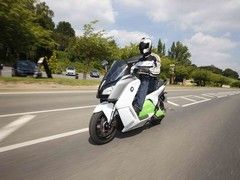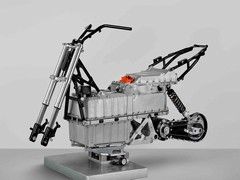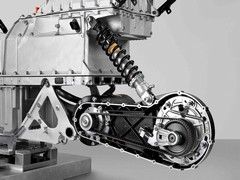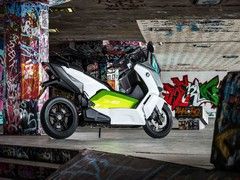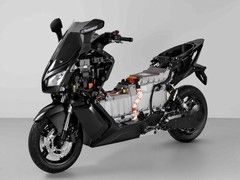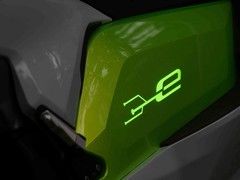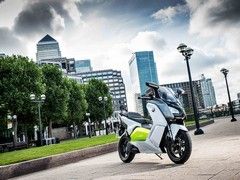PH2 ridden: BMW C evolution
PH2 takes a quiet ride on BMW's prototype electric maxi scooter
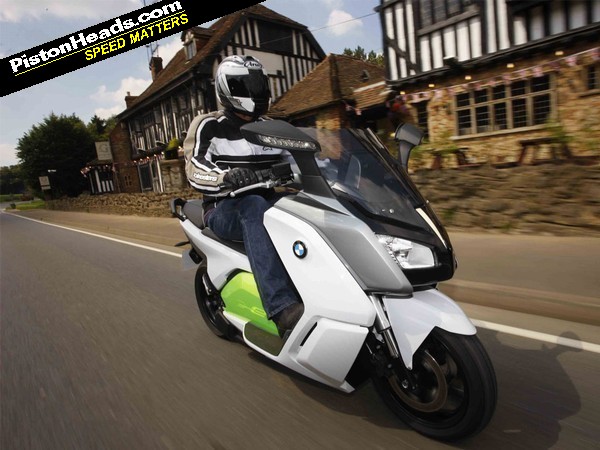
E Scooter
Last year BMW unveiled the C evolution - essentially a battery powered version of its new C-series maxi scooter. What made the C evolution so unique was its size.
Designed for 'proper' commuting, BMW claimed a range of over 60 miles while being capable of over 70mph. In short, this was the first truly viable electric maxi scooter. A year on and PH2 has got the chance to swing a leg over a £300,000 fully-working prototype.
Technology
With all electric vehicles the big issues are battery life, charge cycle and weight - which is where the BMW starts to make sense.
The C evolution uses the same batteries as BMW's future electric cars, the i3 and hybrid i8, but where the i3 car has eight batteries, the scooter has just three. BMW has created a kind of metal box around these batteries to keep them safe and the bike's swingarm and headstock hang off this structure.
In essence the batteries are a structural component of the bike, just like using the motor as a stressed member on a petrol bike. The electric motor is integrated into the swingarm and drives the rear wheel via a toothed belt. Here is where it gets very interesting: despite putting out 35kW of power (approximately 46hp), it is homologated at 11kW (14hp) due to testing procedures - making it learner legal.
How has this happened? The testing procedures require the bike to run at full power for 30 minutes, something a petrol engine can do but an electric can't due to battery life. The longer the bike is run, the lower the power due to conserving the battery and therefore the lower the average power. A coincidence that the BMW hits learner legal power? Not a chance - that's some extremely clever thinking by BMW's design team. Anyone can ride the C evolution on an 'L' plate - meaning you don't have to go through the hassle and expense of passing a full bike test.
Sound of silence
The C evolution was a totally new experience. Everything is different from a petrol vehicle, including start-up. With ignition on, you hold the brake and hit the starter in exactly the same way as a petrol bike. And then silence. No vibration, no exhaust note, nothing. Something inside your head says that opening the throttle won't accomplish anything but it does. With an odd whining noise the scooter moves forward and you are off...
Throttle response was one unknown but the C evolution's twist grip reacts just the same as a petrol scooter. Turn it one way to go faster, close in the other to slow down - no surprises. The amazing thing about electric motors is that there is no dip in the torque or build up of power.
According to BMW the electric bike outperforms the 650cc petrol scooters and it certainly seems sprightly. A claimed 0-30mph in 2.55 seconds seems about right and on the go the C evolution happily keeps up with traffic and will even overtake in national speed limits. We saw 76mph show up on the speedo, just over the 75mph top speed BMW claims. And it handles like a petrol scooter.
With a claimed weight of 265kg it's only 4kg heavier than the petrol version and BMW keeps the batteries low in the frame to improve the handling. At low speed the electric bike is stable and easy to balance and although it's not quite as agile as the petrol bike at higher speeds, there isn't much in it. At the end of the day the electric bike is designed to handle a dual carriageway commute followed by an urban hack, so straight-line stability and easy low-speed handling are very accomplished. The oddest thing about riding the electric bike is hearing all the weird noises such as the fairing creaking and the suspension moving that are usually masked by the sound of a petrol engine...
Is this the future?
While the bike PH2 tested was very much a prototype, it was also remarkably well-finished and the engineers were all speaking about it happening within the next two years rather than being purely a design study. But there is a catch - cost.
Let's not beat about the bush, while we all love trees we also love cash and no matter how ecological a bike is, if it costs three times the amount of a petrol bike then it won't sell. However, as the C evolution shares the same batteries as BMW's electric cars, this will help reduce costs in the long run. BMW is also talking about 'leasing' the batteries to owners (or even the complete bike), again driving down costs. BMW claims the battery has a 10-year or 100,000 mile life with no degrade in performance. The battery will also be replaceable.
A 70 per cent recharge should take less than an hour and give you around 43 miles of riding while a full charge will give you about 60 miles. That's much nearer the figure required by your average commuter and as batteries increase in performance this will almost certainly increase by the time the scooter is launched.
Will a production bike vary much from this prototype? The bike PH2 tested already had ABS but the final version is also likely to have some kind of traction control system to tame that instant torque delivery. The production bike will almost certainly also have reverse (very simple on an electric bike) and GPS built into the dash.
Have we just ridden the future of urban commuting? For someone who just wants to commute to and from the office then the C evolution is certainly the first viable electric bike . Cost is certain to be a limiting factor, as is the UK's lack of enthusiasm for maxi scooters, but it's down to BMW to change car drivers' perspective on bikes.
And that's where the market lies. An owner of an i3 or i8 will be used to electric vehicles and willing to embrace the technology in their commute, hopefully swapping four for two wheels to beat traffic congestion in town. Bikers may be less willing to swap as you are still very limited with what you can do on an electric bike but this may very well change if 'fast charging' points are located at petrol stations. Is electric the future? It is certainly a future if not the future and seeing how it develops in the years to come will be very interesting.
BMW C EVOLUTION
Engine: electric motor with 8kWh of storage capacity
Power: 35Kw
Torque: 72Nm
Top speed: 75mph
Weight: 265kg
Range: 60miles
Price: TBC
Gassing Station | Biker Banter | Top of Page | What's New | My Stuff

